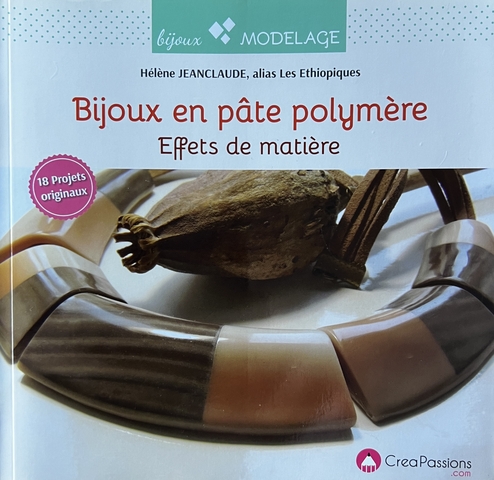Book Review.
I buy and read lots of polymer clay related books so I thought I would put a few reviews out there.
Carol Blackburn
How to Make Pol ymer Clay Beads
ymer Clay Beads
ISBN 978-0-71367-859-8 https://www.amazon.co.uk/dp/0713678593/ref=cm_sw_r_cp_api_i_ms1IDbYPMACD8
Firstly, I can believe this book has not been reviewed by someone before. I often see people on social media asking for recommendations for a good polymer clay book. Nearly everyone recommends Carols book. In addition to that 96% of people who have reviewed the book on Amazon gave it a 5* review. So, they can’t be wrong.
I borrowed this book from my local library before deciding to buy it. It’s a good way to see if a book is going to give you what you need. I ended up buying it from a fellow clayer at a bargain price. If you can only buy one book about polymer clay, make it this one. It’s the one that will cover all the topics you need. And it grows as you grow. I’ll go into more detail about this.
I should say I have so many books on polymer clay and although they're all very good in their own way, some can be a little repetitive on content. Dare I say even boring but not this one, it has got everything you need to know from a beginner to the more advanced. It’s a well written book broken into sections. If you’ve ever met Carol, you’ll know what I mean when I say you can hear Carol’s voice as you read the words. Especially when you read the ‘tips’ that are periodically spaced in each chapter.
Section 1 is all about the basics, making equally sized beads, using classic techniques such as mokume gane, mica shift, inlays, extrusions etc. In the piece about sanding and drilling I learnt some valuable tips that I still incorporate when sanding. You could say this chapter teaches you all the life lessons you need to progress in your work.
Section 2 is all about faux beads showing you how to make beads look like wood, agate, lapis lazuli, silver, jade.... I can go on and on but seriously try the Faux Amber beads, they are lush.
Section 3 has all you need to know about bringing you beads together into pieces of jewellery. This section ‘rounds of the creative process’ nicely without labouring the point.
Do yourself a favour and buy this book. Read it, use it and re read it. Each time I pick it up more of it becomes relevant especially as your skills grow.
Review by Debby Wakley
Bijoux en pâté polymère
By Helene Jean Claude
“Les-ethiopiques”
ISBN 978-2-8141-0334-0
Helene’s work is beautiful, and I think it’s instantly recognisable as “Helene’s work”. Some of you may not be familiar so here’s a link to her Instagram account and her web page.
https://instagram.com/helene.jeanclaude?igshid=1u2j6hnbaacm1
https://helenejeanclaude.wixsite.com/les-ethiopiques/galerie
Anyway, I have loved her work, her use of textures and colours along with her statement collars she often makes me go “I wonder how she did that” I’m sure we all do that with other people’s “wow” work?
So, I saw that she had a book available on Amazon and I added it to my wish list. So, I could look at it in more detail and decide if I wanted to buy it as it was written in French, and I don’t speak French well enough to translate a book. So, I wasn’t sure if it would be a good purchase or not. I promptly forgot about ordering the book only to find it landed in my doorstep as a friend decided with buy it for me! Lucky me!
So, this is a tough book to review fairly as I can’t read 80% of it and google translate is excellent, yet time consuming. So, it’s a visual review with lots of assumptions thrown in.
There are 18 different projects.
An opening section of material and tools which is brief and even with my limited translation skills is easy to follow.
Each of the projects are well laid out, she reveals the products, manufactures and suppliers of the material in each project which is very good. Some artists say use a deep texture sheet whereas she will say which one and whom she purchased it from, very helpful.
There are step by step instructions with matching photos this allows you to follow the project without the need for direct translation.
She gives away a lot of her ‘trade secrets’ in this book more recently she has been putting out YouTube videos of some of the projects in the book.
Her ‘Éruption métallisante’ shows how to incorporate magnetic clasps within her project creating simple yet effective closure in a way that I had not considered before. At the rear of the book there is a section on the templates and shapes, to scale, for the projects.
She’s certainly a clever artist, who has her own methods and techniques, and this is typical of most of the French artists I have met.
Am I glad I have this book in my collection? Oh yes!
Has it inspired me? Absolutely
Was it easy to use despite the language issues? Well enough to not get frustrated.
Does it make good eye candy for us polymer jewellery enthusiasts? I believe it does.
If you can get your hands on a copy I would recommend particularly if you loved Helene’s work.
Review by Debby Wakley
Julie Picarello
Patterns in polymer
ISBN 0871164094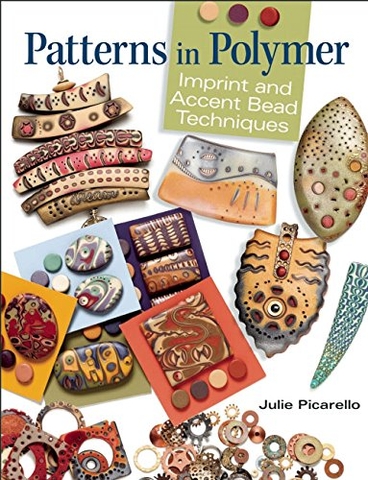
Published 2011
This was given to me as a gift when I first started creating in polymer.
For those of you who have read it will know what I mean when I say “Jecru” that’s the one thing that has stuck and I still use in my colour mixing particularly for Mokume Gane. For those of you who haven’t read the book yet it’s worth getting it for Julie’s take on colour selection, mixing and blending alone. She uses such harmonious blends.
The book starts with a lovely introduction, she doesn’t labour over the basics but goes into details about the tools she specifically uses, I found my purchase of ‘security tools bits’ invaluable to recreating her projects, but this was the only purchase I made. Most of the tools you will already have in your tool kit.
Section 2 is all about how to create the controlled Mokume Gane than she is known for. There are step by step instructions for creating a controlled imprinting pattern, the design, the execution of the patterns, the curing and finishing.
Section 4 is all about the individual projects, step by step instructions on colour recipes, layering, impressioning, slicing, building and structuring pendants.
The book It’s beautifully laid out, easy to follow and certainly inspiring. I would recommend this as a beginner to intermediate book as the technique itself it simple enough but the skills to plan ahead, envisioning the final design before starting takes restraint. I learn that less is more when trying to emulate Julie’s designs.
Reviewed by
Debby Wakley
A new generation of polymer clay
ISBN 978-80-270-6448-9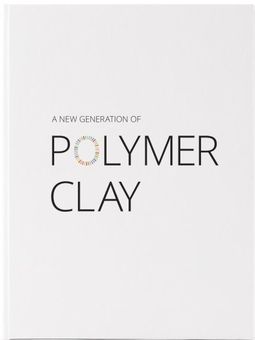
www.polymerweek.com
Lucy Struncova
Firstly, what a wonderful experience, I asked Lucy to donate a copy of the book for the Guild to review. She was really lovely to deal with and very graciously gave us a copy. The book came with a lovely personal message, which was a lovely touch.
My initial impression on first flicking through the book is it’s a beautiful book. Very well put together, glossy, professional, and certainly good eye candy for the coffee table!
27 artists are featured including our very own Fiona Able Smith (congratulations Fiona) but mainly European artists so there is a large diversity of project to look at. Each artist has 8 feature pages, a biography and portrait of the artist, and feature photographs of their work. Giving you lots of visual clues to the work they are best known for. Some truly beautiful work.
Then you come to the tutorials. Each tutorial is laid out the same, so the book has a great sense of uniformity 9 photos per page so 18 for each tutorial and this to me is where I became frustrated. Dare I say a little let down.
The style overrides the substance.
I was asking questions like: - which brand of clay?
Where did you get your cutters from?
Which brand if texture sheet did you use?
I have enough claying knowledge and know how to interpret the vagueness in some of the tutorials, but I did
asked myself if I was being too picky. So, I got my 18year old to have a look at the book and tell me what she thought.
“It’s a lovely book but it assumes you know what you are doing, it would not be suitable for beginners or novices”.
Will I be doing any of the projects from the book? Yes, 9 of them really appeal to me. Personally, I would photocopy the project and use those notes to guide me though the project. The book is way too nice to get all messy in your studio.
On a side note, I was curious about one of the projects and had “questions”, so I contacted the artist via Instagram, she was lovely, very kind and helpful giving me the info that I felt was missing from the tutorial. This has always is my experience within this wonderful world of polymer clayers.
It’s a great polymer clay book, full of beautiful glossy photos, certainly a good read, but it is not a step-by-step tutorial book for beginners.
Review by Debby Wakley
Ancient modern
Ronna Sarvas Weltman
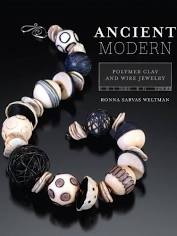 ASIN : B00DH40WLI
ASIN : B00DH40WLI
I’ve loved seeing Ronna’s work, I love the organic, fluid nature of her work. So this book had been on my wish list for a while.
The book starts with a lengthy (33 pages) introduction section that covers jewellery design, wire techniques and polymer clay basics.
She starts by talking about the 6 principles of design, the colour wheel and where to find inspiration. She then jumps into jewellery mechanics, giving suggestions for weighting the elements so necklaces, bracelets and rings hang correctly. She includes really helpful charts, like the one showing the names and ranges for standard necklace sizes. The wire work section I found informative but there were lots of extra pieces of equipment you’d need to buy to complete these techniques (quite expensive items too. I decided I’d like to acquire a couple of the tools but the price to buy these here in the U.K. meant a ball-peen hammer and bench block we’re all I could justify buying)
In conclusion the first section was informative, educational, and inspiring and the information would be good for beginners and intermediate jewellery makers alike.
There are 15 projects, including 6 necklaces, 4 bracelets, 2 earrings, 2 rings and 1 brooch. Each of the projects is then broken down into multiple parts. For example, the first necklace has instructions for making 12 different beads.
This for me is where is starts to go wrong.
For each project there is an image of the finished design.. Each bead has a few step-by-step photos. But she doesn't show detailed photos of each completed bead. Each bead type has a ‘name’ which wasn’t always helpful either. I kept having to flip back and forth to the beginning of the chapter to see which bead we might be working on next and to see how the bead should end up looking.
The step-by-step photos are pretty good. I like that they were large enough to show detail. I just wish they had lined up better with the text they were illustrating.
The instructions were well-written overall, but two things bugged me. First, the Zebra Cane was repeated word for word — THREE times! The wire-ball bead instructions are also repeated. But even though there's plenty of other information in the book to make it worthwhile, those repeats made me feel cheated though. I kind of expected more, it was like they were just padding the book out. It undervalued the book.
The second thing that bugged me was the other extreme. Often, instead of writing out the steps again, you were asked to repeat steps 1-5 in previous chapter or where step 17 says to repeat 19-21, step 23 says to repeat 24-27, and step 19 says to repeat 19. Sometimes it was mind boggling to follow. So I didn’t !
All in all I felt it was a clumsy construct of a book.
Into the positives.
The glossy photographs of the projects are wonderful eye candy.
On the whole the instructions were easy to follow. It helps that the polymer clay techniques in this book are pretty basic beginner level techniques.
The organic feel to each project came across well showing that you don’t need to be precious about creating the beads, it’s part of the organic design. This is something she does so well, it’s liberation as she makes you feel there really are no mistakes. It's all about creativity and enjoying the process.
Review by Debby Wakley.
Bettina Welker
Polymer clay Bracelets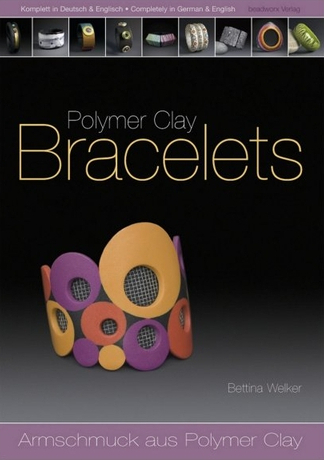
Publish in 2012
I first met Bettina at the inaugural Polymania, her work really inspired me, her use of colour and textures igniting my passion for textures in a big way. So when I found out she had a book on bracelets I just had to buy it. What do I think of it? I love it, a fabulous book, project based, lots of transferable techniques.
So let me break it down, it’s a clear concise book, not a beginners book, you need to have some existing skills to make some of these projects work well. It’s written in German and English with step by step instructions, they are thoughtfully composed to give you exacting instruction that enable you to follow the projects clearly.
The fore section explains about polymer clay, the tools, material and the basics techniques you need to understand for the projects importantly you are guided through building a bracelet blank which is important to the following projects.
There are 10 projects broken down into 4 sub sections covering bangles, stretch tile bracelets, cuffs and a hinged magnetic bracelet.
The instructions are accompanied by beautiful step by step pictures that demonstrate the stages for each project. In fact the photography and imagery is a work of art in itself.
You get to understand the construction process, templates are provided so you can follow exactly as instructed but then Bettina goes into detail on the use of blends, creating textures, using surface techniques that give each project its unique look. Each project is packed with tips and tricks to ensure success. These skills are all transferable to other projects.
If I had to criticise the book at all it would be that some of the forms and materials were not that easy to acquire. One of the projects requires a metal pyramid form, it wasn’t easy to find, if you’d like to borrow it let me know as I found one and completed the square bangle project.
For me this is a book to have in your collection, it’s not just about bracelets it’s so much more. In fact it’s the book that first got me exploring crackle techniques too. And I love crackle and in many ways I have Bettina to thank for my obsession with crackled clay.
The book is available to buy from Bettina on her Etsy page where she has 322 positive reviews so other people think it’s s pretty good book too.
Review by Debby Wakley

